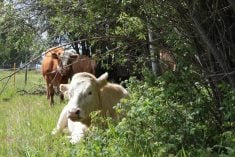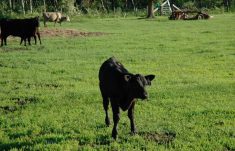The first castration banders were likely developed to replace knife or scalpel castration. They were easy to use and eliminated the complications of infections and blood loss.
Castration with a knife or scalpel is harder to master and animal welfare issues must be considered.
Banders have been around for a while; I recently saw an almost antique one that still worked to put green bands on young calves. Skill is needed, though, when using green bands. Always check for two testicles within the band, because retained testicles in a feedlot situation are troublesome. Checking and removing a retained testicle from improper banding causes weight loss from stress in a feedlot animal and can also involve mortality. As well, a skilled person is needed to complete the castration.
Read Also

Harvest wraps up and fall work begins
At the Eppich famly ranch in western Saskatchewan, the fall harvest was successful with few breakdowns, cows and calves have been sorted and a new tractor has arrived
Banding and implanting are two skills in the cattle industry that can be hard to master. We do audits on implants, and it would be interesting to see how a banding audit would turn out. It can certainly be tricky to properly band a calf when an overzealous cow is bearing down on you.
Small bands impregnated with lidocaine are now available from your veterinarian. The pain relief they provide makes for better health outcomes and potentially better performance, which should be a slam-dunk, in my opinion. They also follow animal welfare guidelines.
The small bands are also applied, with a veterinarian’s discretion, for small tumour and wart removals in some cases, especially if one is worried about blood loss.
The large banders have almost replaced knife or scalpel castration on large bulls in the feedlot, and practice makes perfect. Good technique makes the process less labour-intensive and lowers risk because there is no blood loss.
Calves being banded will require a tetanus shot — meaning a clostridial vaccine that contains tetanus — ideally given two weeks before you band, then boostered at banding time. The cost of the vaccine is low compared to a sure death if the animal gets tetanus.
All tetanus cases I have seen in practice or consulted on were in large bull calves banded with bigger bands and not vaccinated for tetanus. Tetanus comes with 100 per cent mortality, so prevention is worth it.
Lots of other uses have been developed for larger bands. When amputating prolapsed rectums, veterinarians have developed a technique using an indwelling tube. The band slowly causes the rectum to slough off and heal. The success rate with the bander is as good as any other surgical technique.
Veterinarians have also learned to treat external tumours using banders as a tourniquet to prevent blood loss.
Larger bands can be purchased, or made, for uterine amputation from a prolapsed uterus that has become severely lacerated. Use of a bander on a severe prolapse has saved the lives of many cows — but the decision should be left to your veterinarian.
I have been asked whether a band can be used in the case of a badly torn uterus that can’t be sewn after a C-section. In that case, I would prolapse the uterus and do it out the back end where you have better control and less chance of infection.
The band eventually falls off and passes out the vagina, so no foreign object is left in the carcass.
Different-sized banders have been developed to castrate calves up to about 700 pounds. These bands will soon be impregnated with lidocaine, so one can feel good about looking after animal welfare.
Castration bands were developed for livestock species that have a pendulous scrotum, such as cattle, sheep or goats. Species with tighter scrotums such as pigs and horses continue to need surgical castration.
Always be aware of new developments in banders and applications as they are improved by research and the veterinary community.















